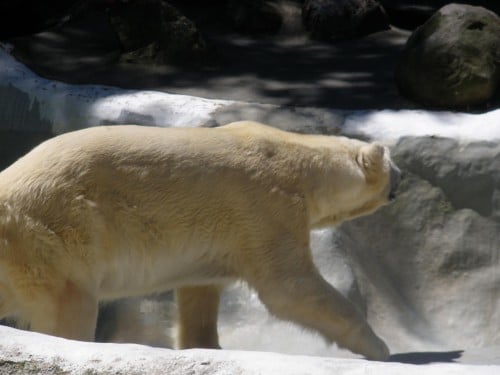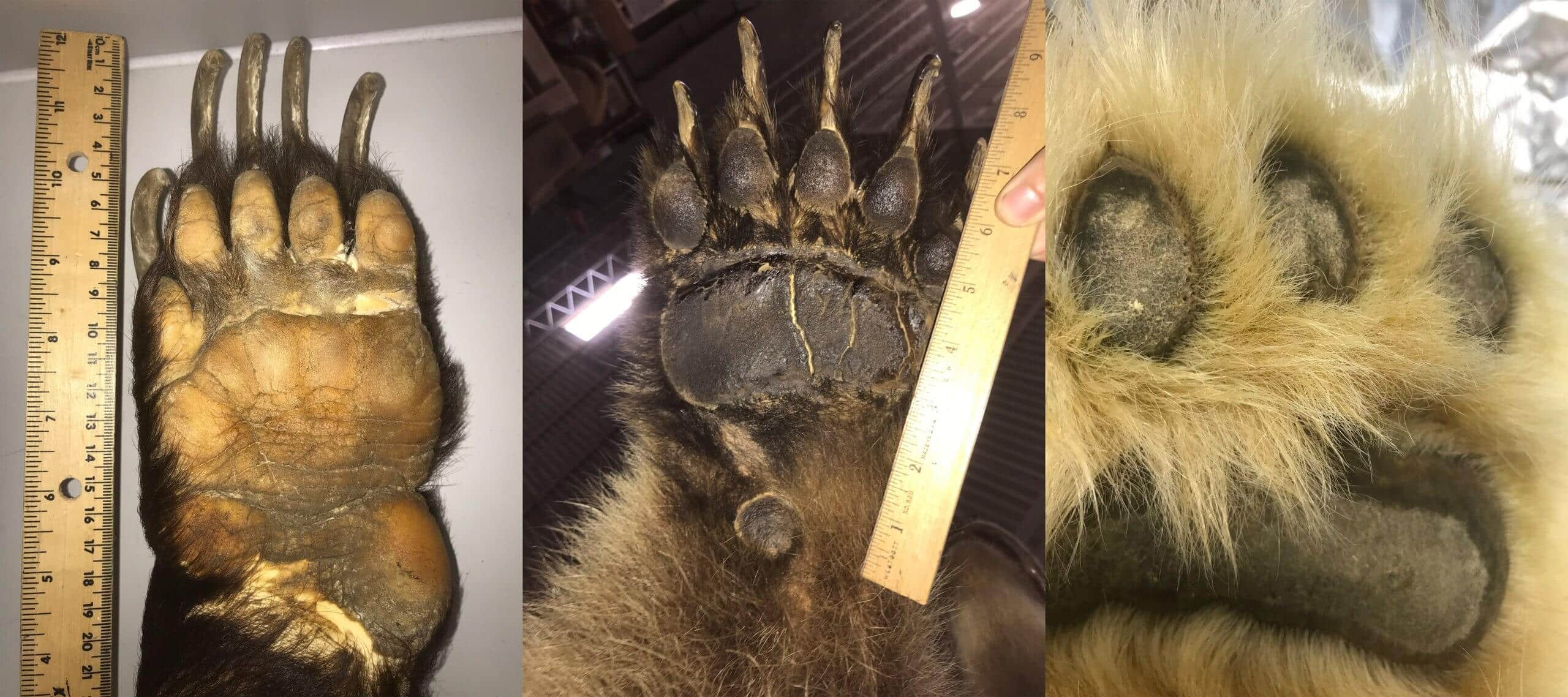Special for Polar Bear Day: American researchers have discovered the reason why polar bears walk without difficulty on ice and snow surfaces that would cause each and every one of us to slip - microscopic bumps that line their furry feet
Yonatan Sher, Angle - news agency for science and the environment

If you've ever tried to walk on slippery ice or snow surfaces, you probably know that this is a task that usually ends in thunderous laughter from those who see you fall - and land on your butt, of course. Don't worry, these falls are nothing to be ashamed of: nature did not gift us with the skill of balancing on ice, given the fact that modern humans developed through an evolutionary process in not-especially-frozen Africa.
בA new American study We will examine a mammal slightly different from us - the polar bear (ursus maritimus), which nature definitely requires him to deal with Walking on smooth and icy surfaces For his survival, and unique tiny structures were found in his feet that developed to allow him to walk on them safely. It seems that the phrase "if God wanted us to fly, he would give us wings" could have an addition - if he wanted us to walk on the ice, he would give us polar bear feet.
in honor of International Polar Bear Day, which is celebrated every year on February 27 (the date when polar bear mothers and their cubs snooze together in their dens): How do polar bears' non-slip feet differ from those of other bears? And why did the research that examined this question receive funding from a company that manufactures car tires?
If God wanted us to walk on ice, he would give us polar bear feet. All rights reserved to Amir Laban
As their name suggests, polar bears live in the Arctic region, and roam between the borders of five countries: the United States, Canada, Russia, Greenland in the Kingdom of Denmark and Norway. They are the largest land carnivores on Earth, with the largest males standing at around 3.3 meters tall when standing on their hind legs and weighing up to 770 pounds. Sea bears have black skin (what you have heard), a blue tongue and transparent fur that reflects the white light rays of the sun and gives them their familiar blue color. The feet of polar bears are small compared to those of other bears, and researchers estimate that this is an adaptation designed to reduce body heat loss.
It should be noted that this is still an impressive foot. "The first time I was exposed to a polar bear was through Aqaba, which I saw on a frozen beach in Svalbard (an archipelago that forms the northernmost part of Norway, Y.S.)," says Amir Laban from the nature conservation division of the Nature Protection Society, an expert in urban nature and a polar tour guide. "Its surface area was not large compared to the bear's body - and yet, we can put both of our feet inside one of their footprints."
Small bumps, big grip
In the new study, published in the Journal of The Royal Society Interface, the researchers set out to check what is the factor that allows polar bears to walk freely and easily on smooth surfaces, by examining their feet. Previous research, from the 80s, found that polar bears' paws are paved in papillae - Small, round bumps that emerge from the body. The human body also has papillae: in the tongue, for example, they are responsible for creating the rough surface (unfortunately, the relationship between the roughness of the tongue and the ability to lick frozen ice cream was not examined in the current study).
Are the papillae in the polar bears feet responsible for creating the sufficient friction between it and the smooth ice surface? To answer this question, the researchers compared the paws of polar bears to those of bears of three other species, which do not spend as much time walking on ice or smooth snow surfaces. They examined 13 foot samples from 5 polar bears, 4 brown bears, 3 American black bears and a Malayan bear (sun bear) one. It is important to note that no bear was harmed for the purpose of conducting the research, and all samples came from museum collections or private taxidermists. In the first step, the researchers scanned the surface of the feet using an electron microscope to simulate and measure the height and width of the papillae emerging from them.
The researchers found that there are papillae on the feet of the three bear species from North America - the polar bear, the brown bear and the black bear (but not on the feet of the Asian Malay bear). However, the height of the papillae in relation to their width was 1.5 times greater in the polar bears compared to the brown and black bear. According to the researchers, this fact causes an increase in the surface of the polar bears' feet - the higher the papilla, the more surface area it "creates". You can think of any such bulge as a skyscraper: the higher it is, the more windows are needed to cover its surface. The result is that for every square centimeter of the foot, the surface area in the feet of polar bears is 30 percent greater than that of the feet of the other two North American bear species.
In the second phase of the study, the researchers printed 50D models of the bears' paws that were scanned and tested the friction created between the models and a snow surface that they created in the laboratory. The findings showed that the polar bear foot models created 30-XNUMX percent more friction with the snow surface than the foot models of the other two bears with papillae. According to the researchers, the extra roughness created by the greater height of the polar bears' foot papillae allows them to produce better grip on the smooth surfaces they walk on.
A bear is disappearing
According to estimates Today there are about 26 thousand polar bears in the wild - and counting rapidly diminishing. This is due to the climate crisis, which leads to the loss of the sea ice layer the bears need for Seal hunting – their main food source. Laban has been traveling in the Arctic region and meeting bears for almost 15 years, and he tells about the noticeable differences throughout this period. "I've seen several times starving bears and dead bears," he says. "We see changes in the habitats, mainly in the quantity and quality of the sea ice and the shortening of the cold season, which is critical for the entire Arctic food web."

If you are interested in watching these impressive animals, Laban emphasizes that they should be given space and respect. "The safest way to see the bears is by boat," he says. "It is very important during the observation not to chase the bears, because energy is a critical resource for the existence of wild animals in the Arctic Circle, and causing a waste of energy is a terrible thing." White says that there is also a possibility Meet polar bears on foot, in places like Hudson Bay in Canada - as long as you keep a distance from them. "You can walk around there and follow females with puppies, or young males playing. When you see a polar bear stand on its two hind legs, it's a pretty amazing sight."
Tires inspired by bears
Of the researchers who led the new study, one employed by the Bridgestone Americas company - which, among other things, deals in tire production, and the research was also partially financed with the help of the Goodyear tire and rubber company. This is related to the purpose of the study: according to the researchers, it is intended to help develop better snow tires, as well as other anti-skid equipment, such as gloves or shoe soles.
The turning of scientists and engineers to the kingdom of nature to take inspiration and develop products is the heart of the fieldBiomimicry (Biomimicry). "'Bio' is life and 'mimicry' is imitation," explains Dr. Yael Halfman, founder and CEO The Israeli Biomimicry Organization and the biomimicry company Nature Code. "It's about looking at nature as a huge reservoir of solutions, with the basic premise being that many of humanity's challenges have already been solved in nature." According to her, man is a part of nature - therefore, the constraints that act on nature, and on various animals that have developed ways of surviving in difficult conditions, are also relevant to us, in areas such as energy, water, security, communication and more. "Nature is the greatest of designers, which has never finished and will never finish. Everything exists in nature, and it has a tremendous advantage in terms of time - nature had 3.8 billion years of research and development as part of evolution."
According to Helfman, examples of products developed using the biomimicry method include wall paints that repel water and dirt in a way similar to the way the lotus flower maintains its iridescent cleanliness, and a swarm of drones developed by Raphael that imitates the activity of a flock of birds in the wild for purposes of activity on the future battlefield.
"In the case of the new study, since the polar bear lives on ice that is difficult to cling to, there are structures in its body that are adapted to its living environment," says Halfman. "In fact, the researchers who try to develop different solutions receive a pre-prepared shape, size and texture, with proof that they meet certain weight and temperature conditions."
If the new research does advance the possibility of creating more stable snow tires, it is hoped that they will also be made of materials that cause less environmental damage than Those that exist in most tires today. According to Helfman, even in this context it is useful to take inspiration from the environment. "In nature, every creature nurtures its environment by its very existence - for example, a tree that produces oxygen and gives a home to birds," she says. "Just imagine that we were to design products that would behave in this way, and that their very existence would produce a positive impact for the environment. We have an opportunity as engineers and planners to plan a different future", she concludes.
More of the topic in Hayadan:
- Knut - the celebrity polar bear at the Berlin Zoo - has died
- Climate disruptions, extreme weather events and global connections: the Arctic is crying out
- To learn from the polar fish how to preserve blood and tissues for a long time
- Volunteers will be "tortured" to check whether religious belief helps in pain relief
- The new Polar Bear menu
